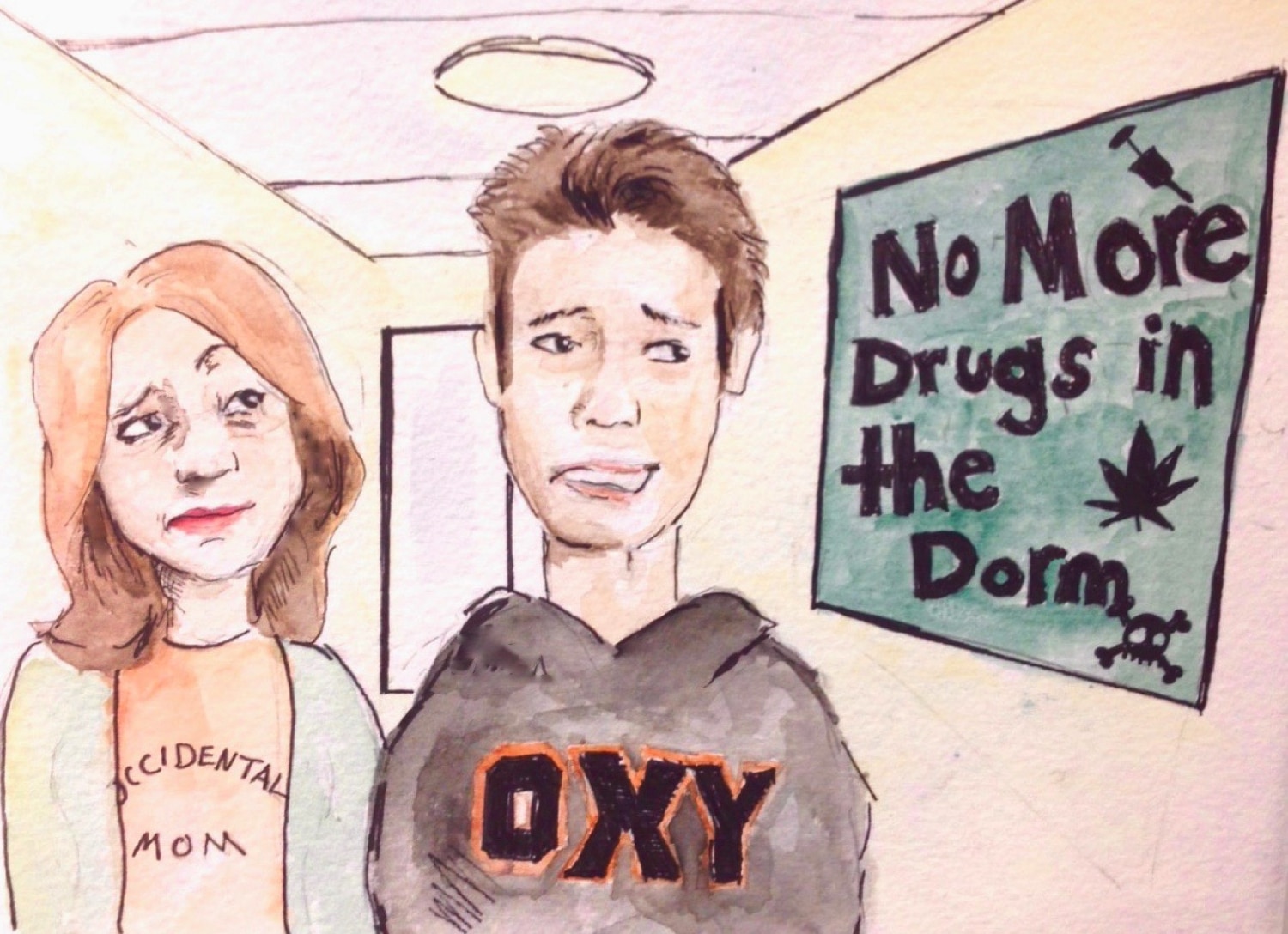“MARIHUANA: WEED WITH ROOTS IN HELL,” screams one 1936 anti-marijuana movie poster emblazoned with pictures of a dejected woman; joints labeled with words like “Lust,” “Crime” and “Sorrow;” and, for some reason, three syringes. “WEIRD ORGIES, WILD PARTIES, UNLEASHED PASSIONS!” says the bottom of the poster in bright red font.
Posters like this are, of course, laughably inaccurate — unless I’ve just been going to the wrong kind of parties. But although most of us are informed enough today to recognize them as blatant fearmongering, current anti-drug campaigns still commonly feature misinformation and scare tactics — and the posters that Occidental’s Alcohol and Other Drugs Committee (AODC) recently plastered around the school are no exception.

I’m sure that the AODC was well-intentioned in creating the posters, all of which advertise Emmons counseling for drug addictions in small text at the bottom. The content of the posters, however, spreads misinformation and manipulate students’ shame and fear to encourage them to stop using drugs. None of the posters approach addiction compassionately — in fact, aside from the small print at the bottom, they don’t directly mention it at all.
Other students share these concerns. Occidental’s Students for Sensible Drug Policy (SSDP) created a Facebook post March 5, criticizing the posters’ misleading language and lack of concrete safety tips.
Let’s start with the poster about marijuana. This poster claims that “a typical marijuana edible may contain the same amount of THC as 15–20 joints” and advises students “[not to] eat the whole cookie,” citing an article from The Stranger, a Seattle newspaper, for the statistic. Although anyone who has indeed eaten the whole cookie can tell you that the advice is sound, the facts are not. The article, which is about the safe use of marijuana edibles, mentions nothing about joints’ THC content. Instead, it informs users that 30–40 mg of THC should be enough to provide a “good, strong, memorable experience” for “the average pot smoker.” (Edibles typically contain 5–100 mg of THC.)
An article from The Cannabist, however, claims that the average joint contains about 42 mg of THC, and that 40–50 percent of that THC is lost in the process of smoking it. I’ll (generously) assume the AODC’s poster meant that edibles contain 10–15 times the amount of THC that you actually ingest from a joint, not the amount that the joint contains overall. Even by that estimate, the poster would be claiming that “a typical marijuana edible” contains at least 210 mg of THC — a number as insanely high as you’d be if you ate that hypothetical edible.
Let’s move on to the second poster, which concerns cocaine. It warns students that 71 percent of cocaine samples tested in 2009 contained levamisole, a deworming medication that can cause health problems such as necrosis. Beneath the statistic is a photo of cocaine and the words, “Does Oxy have a problem?”
If Oxy does have a problem, that poster isn’t going to solve it. The levamisole statistic is true, but trying to scare students away from using drugs is an ineffective and even counterproductive tactic. According to an article from the National Center on Addiction and Substance Abuse, scare tactics don’t work well for repeated behaviors and behaviors that help avoid health problems, like daily exercise, wearing sunscreen — or not doing cocaine. One experiment from the Society for Research on Nicotine and Tobacco even found that teens who had previously expressed interest in smoking became even more interested when they were exposed to graphic anti-smoking posters.

The third poster, which concerns prescription drugs, does include accurate information, but its language lacks compassion. It says that “by students’ sophomore year in college, about half … will have been offered the opportunity to abuse a prescription drug. If it’s not prescribed for you, it’s not for you.” The poster does have a valid point; students who use prescription pills as party drugs may not only harm themselves but also contribute to the stigma around the conditions those drugs are meant to treat.
Unfortunately, the poster trades one kind of stigma for another. Its commentary (“It’s not for you”) lends it a scolding tone — a fairly unsympathetic choice for an advertisement for counseling services. As the SSDP’s Facebook post points out, its use of the word “abuse” also contributes to the stigma surrounding drug addiction, which may discourage students from seeking the help they need.
Clearly, the AODC is trying to be helpful in discouraging students from using drugs, and their efforts are crucial. College students are more likely to use marijuana, binge drink and take amphetamines than their non-college peers, and we need access to accurate information about these drugs so that we know how to approach them responsibly. But this poster campaign is ultimately about as useful as a drawing of a “marihuana” syringe. I urge the AODC to use more effective methods of drug prevention in the future by demonstrating compassion for students struggling with addiction and providing us with accurate facts. In fact, the most successful anti-drug campaigns don’t mention drugs much at all, but instead, emphasize mental health and social connection so that young people don’t feel the need to use these substances in the first place.
Natalie Ray is an undeclared sophomore. She can be reached at nray@oxy.edu.
![]()



































